Perception of Citizens Regarding Marine Litter Impacts: Collaborative Methodologies in Island Fishing Communities of Cape Verde
Abstract
1. Introduction
2. Case Study
3. Materials and Methods
3.1. Problem Identification
3.2. Stakeholder Selection
3.3. Consultation and Involvement
3.4. Capacity Building
3.5. Evaluation and Reporting
4. Results
4.1. Participants Characterization
4.2. Participants Views about Marine Litter
5. Discussion
6. Conclusions
Author Contributions
Funding
Acknowledgments
Conflicts of Interest
Appendix A
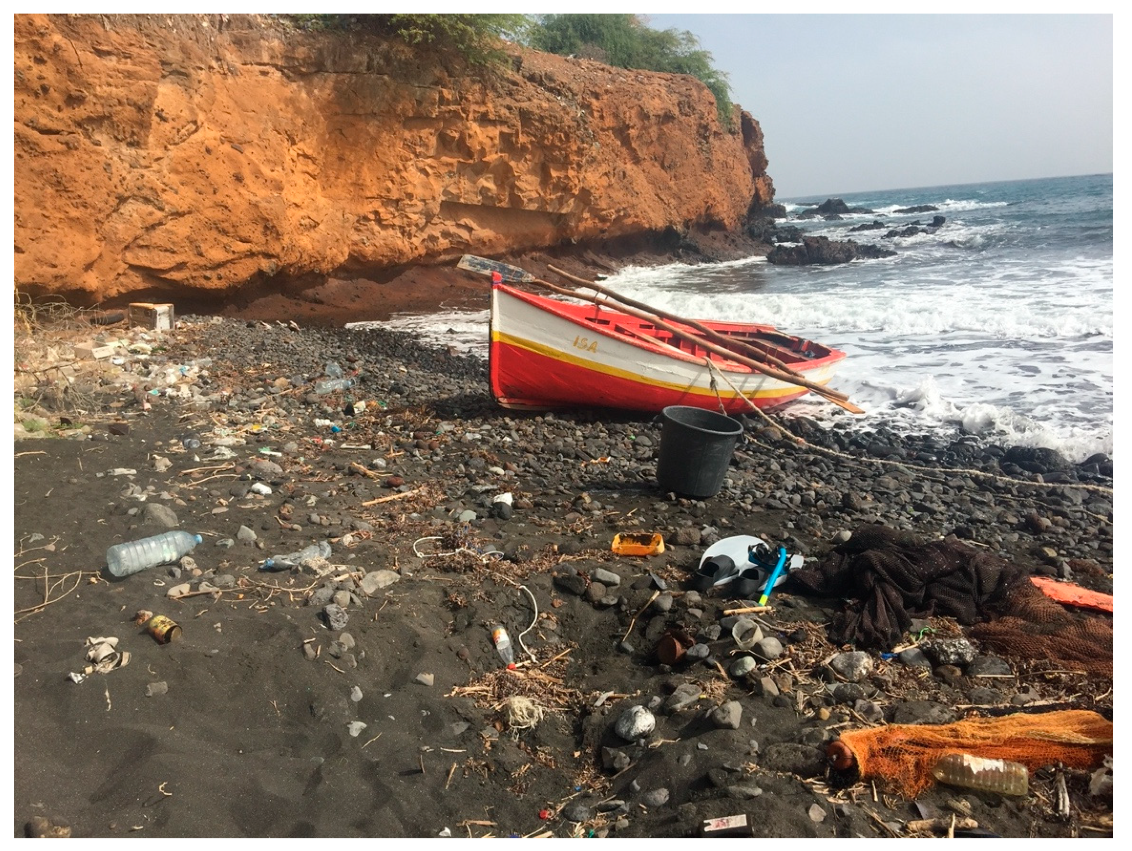
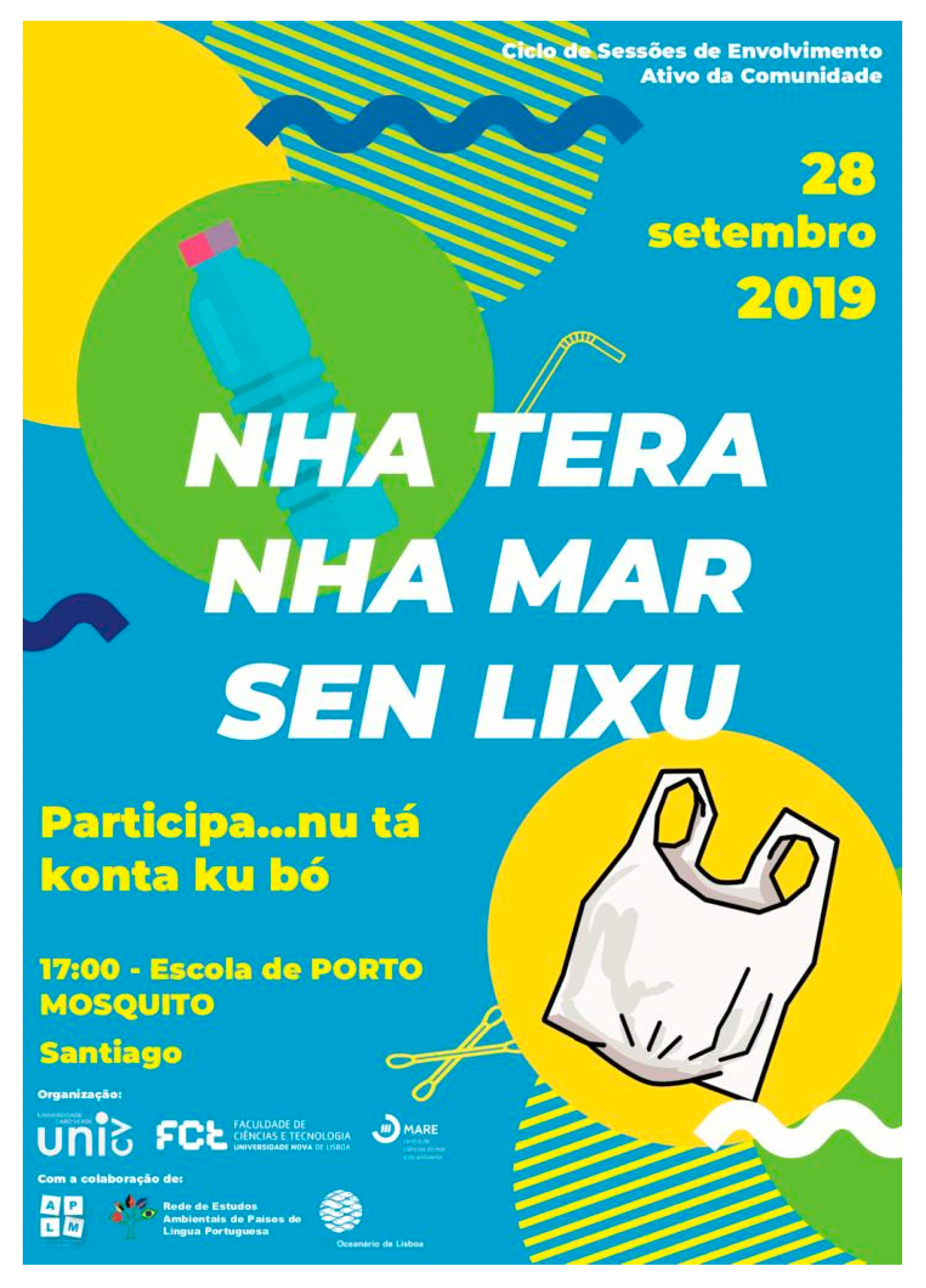
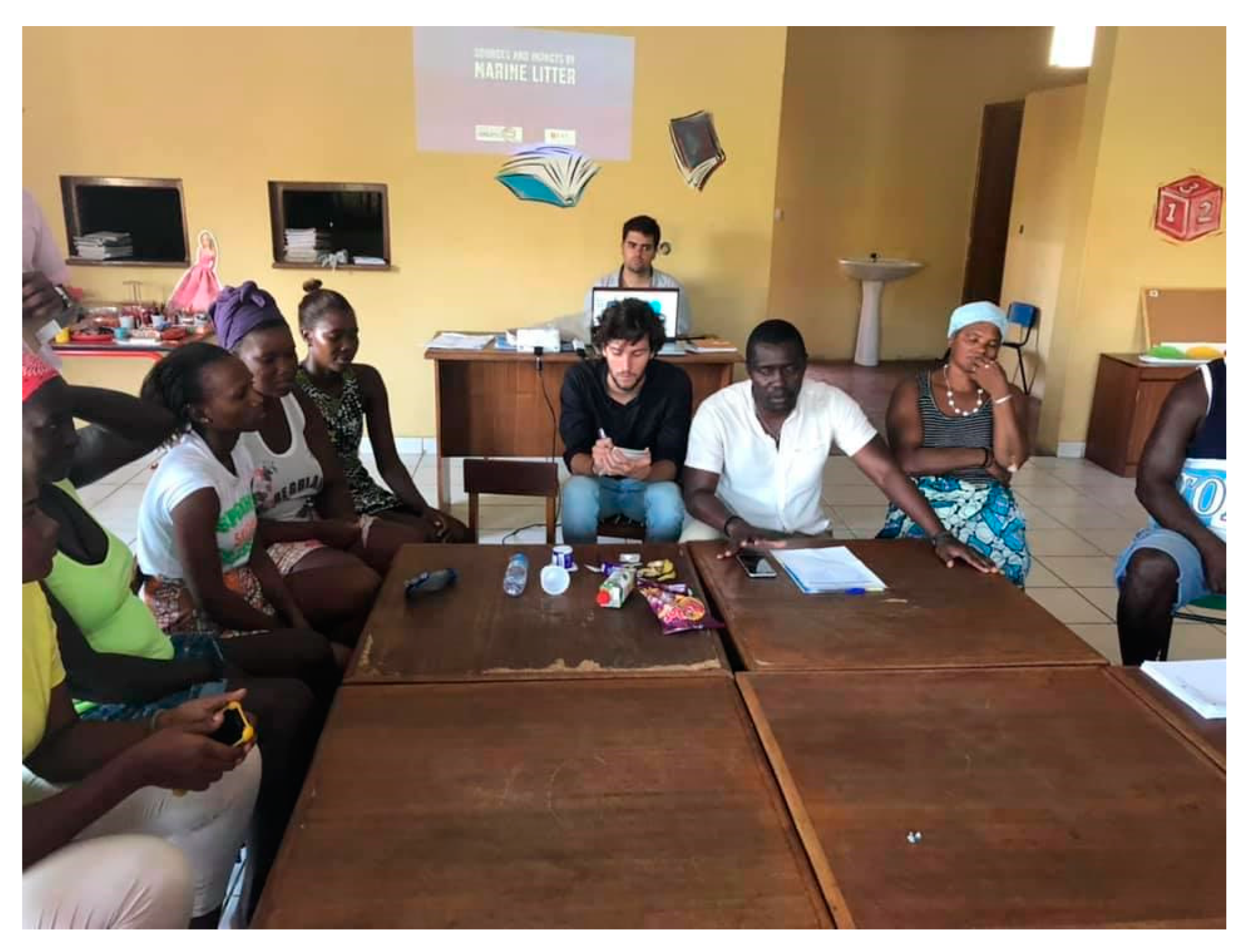
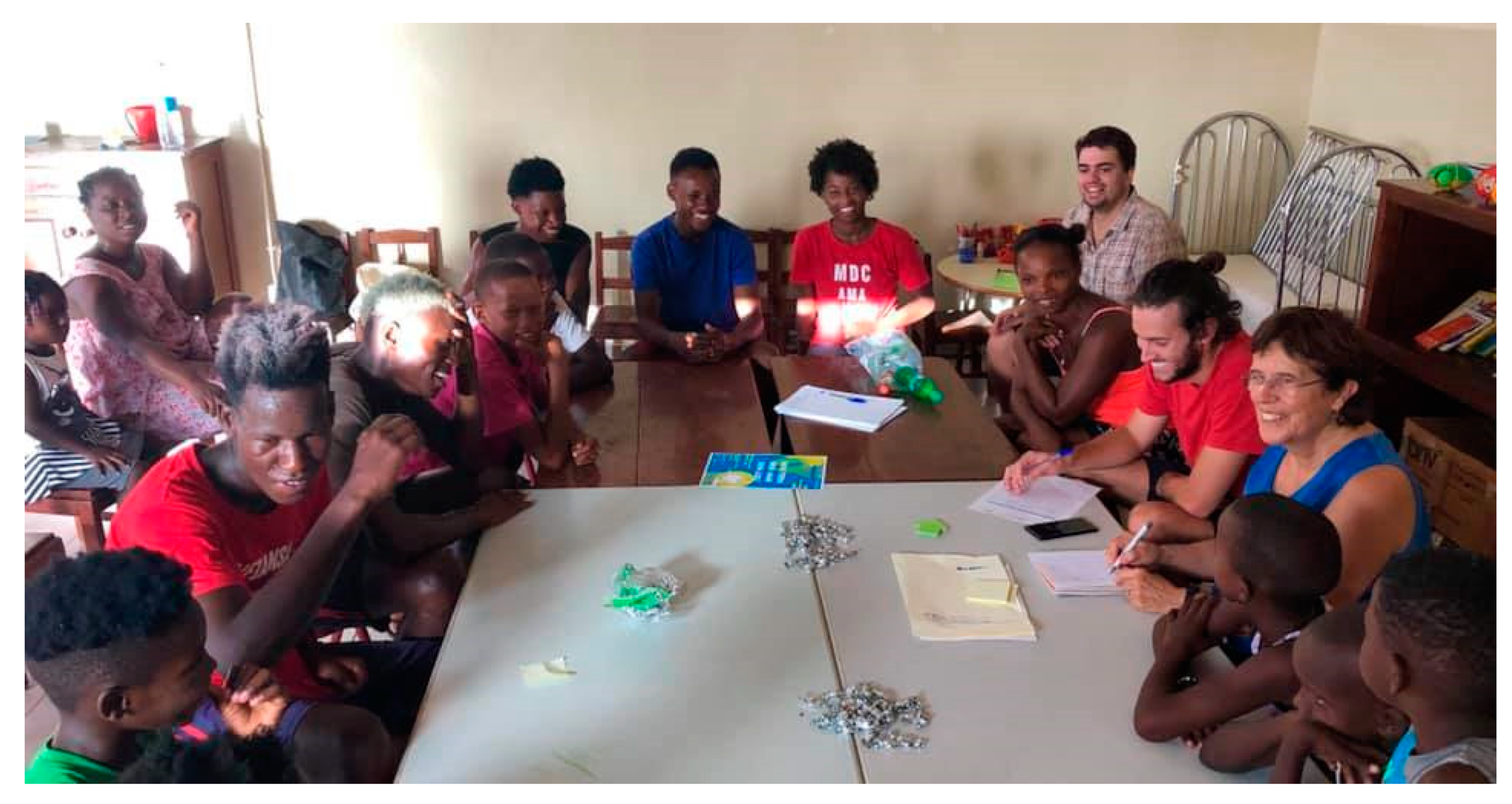
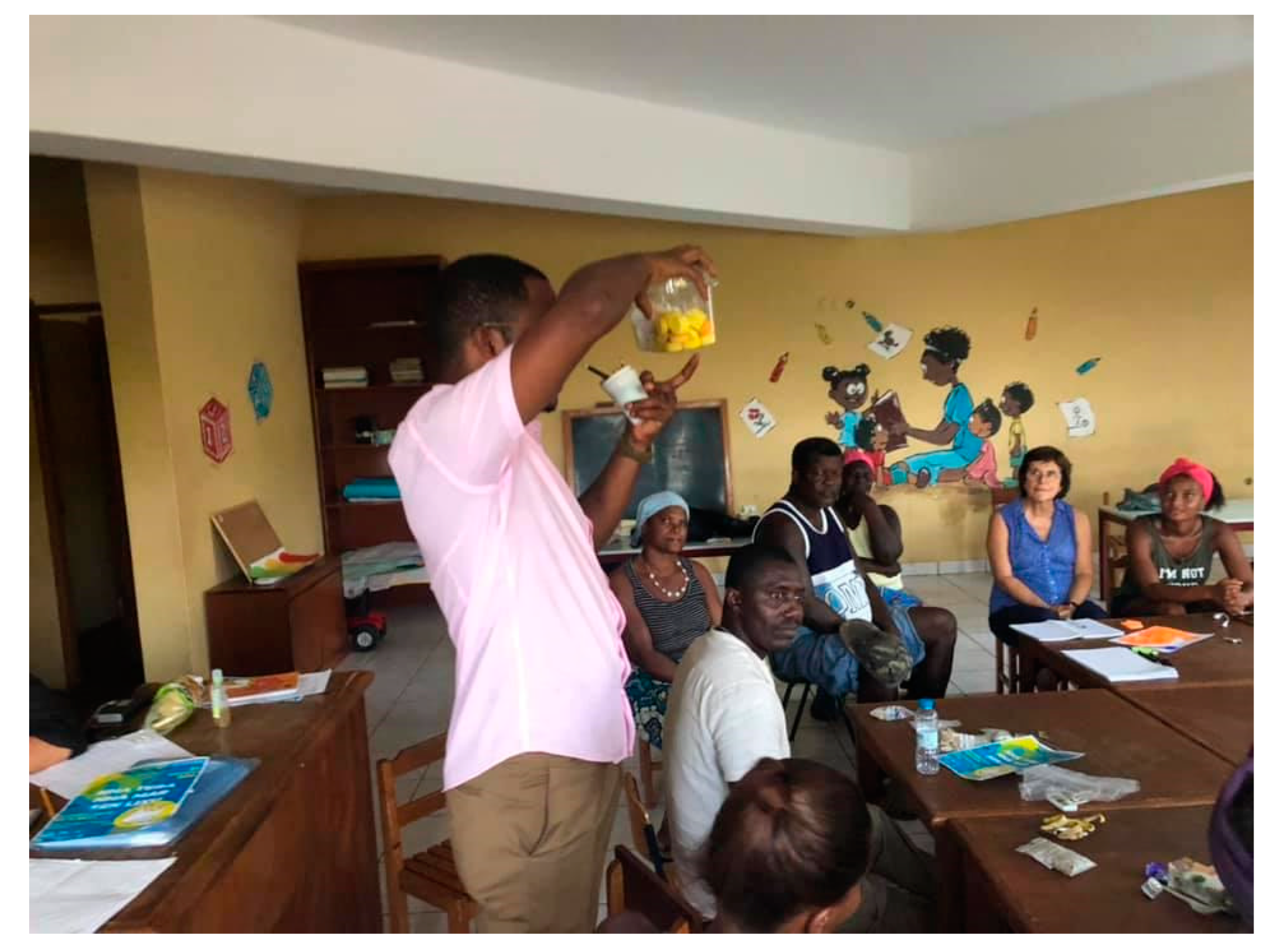

References
- Hartley, B.L.; Pahl, S.; Veiga, J.; Vlachogianni, T.; Vasconcelos, L.; Maes, T.; Doyle, T.; d’Arcy Metcalfe, R.; Öztürk, A.A.; Di Berardo, M.; et al. Exploring public views on marine litter in Europe: Perceived causes, consequences and pathways to change. Mar. Pollut. Bull. 2018, 133, 945–955. [Google Scholar] [CrossRef]
- Veiga, J.M.; Vlachogianni, T.; Pahl, S.; Thompson, R.C.; Kopke, K.; Doyle, T.K.; Hartley, B.L.; Maes, T.; Orthodoxou, D.L.; Loizidou, X.I.; et al. Enhancing public awareness and promoting co-responsibility for marine litter in Europe: The challenge of MARLISCO. Mar. Pollut. Bull. 2016, 102, 309–315. [Google Scholar] [CrossRef]
- United Nations. United Nations Official Document. Available online: https://www.un.org/ga/search/view_doc.asp?symbol=A/RES/66/288&Lang=E (accessed on 26 February 2020).
- G-7 Leaders’ Declaration. Available online: https://obamawhitehouse.archives.gov/the-press-office/2015/06/08/g-7-leaders-declaration (accessed on 20 November 2019).
- European Commission Marine Strategy Framework Directive: Task Group 10 Report: Marine Litter. 2010. Available online: https://op.europa.eu:443/en/publication-detail/-/publication/08be7101-11c9-42f2-a36a-eba2a99a3636/language-en (accessed on 26 February 2020).
- United Nations. Marine Litter, an Analytical Overview; UNEP: Nairobi, Kenya, 2005. [Google Scholar]
- Consoli, P.; Falautano, M.; Sinopoli, M.; Perzia, P.; Canese, S.; Esposito, V.; Battaglia, P.; Romeo, T.; Andaloro, F.; Galgani, F.; et al. Composition and abundance of benthic marine litter in a coastal area of the central Mediterranean Sea. Mar. Pollut. Bull. 2018, 136, 243–247. [Google Scholar] [CrossRef] [PubMed]
- Derraik, J.G.B. The pollution of the marine environment by plastic debris: A review. Mar. Pollut. Bull. 2002, 44, 842–852. [Google Scholar] [CrossRef]
- Ryan, P.G. A Brief History of Marine Litter Research. In Marine Anthropogenic Litter; Bergmann, M., Gutow, L., Klages, M., Eds.; Springer International Publishing: Cham, Switzerland, 2015; pp. 1–25. ISBN 978-3-319-16510-3. [Google Scholar]
- OSPAR. Marine Litter Regional Action Plan; OSPAR: London, UK, 2014. [Google Scholar]
- Aytan, U.; Sahin, F.B.E.; Karacan, F. Beach Litter on Sarayköy Beach (SE Black Sea): Density, Composition, Possible Sources and Associated Organisms. Aquat. Sci. 2019, 20, 137–145. [Google Scholar]
- Gall, S.C.; Thompson, R.C. The impact of debris on marine life. Mar. Pollut. Bull. 2015, 92, 170–179. [Google Scholar] [CrossRef] [PubMed]
- Velez, N.; Zardi, G.I.; Lo Savio, R.; McQuaid, C.D.; Valbusa, U.; Sabour, B.; Nicastro, K.R. A baseline assessment of beach macrolitter and microplastics along northeastern Atlantic shores. Mar. Pollut. Bull. 2019, 149, 110649. [Google Scholar] [CrossRef]
- OSPAR. Monitoring of Marine Litter in the OSPAR Region; OSPAR: London, UK, 2007. [Google Scholar]
- Barnes, D.K.A.; Galgani, F.; Thompson, R.C.; Barlaz, M. Accumulation and fragmentation of plastic debris in global environments. Philos. Trans. R. Soc. B Biol. Sci. 2009, 364, 1985–1998. [Google Scholar] [CrossRef]
- GESAMP. Sources, Fate and Effects of Microplastics in the Marine Environment (Part 2). Available online: http://www.gesamp.org/publications/microplastics-in-the-marine-environment-part-2 (accessed on 26 February 2020).
- Moore, C.J. Synthetic polymers in the marine environment: A rapidly increasing, long-term threat. Environ. Res. 2008, 108, 131–139. [Google Scholar] [CrossRef] [PubMed]
- Thompson, R.C. Lost at Sea: Where Is All the Plastic? Science 2004, 304, 838. [Google Scholar] [CrossRef]
- Plastics Europe. Plastics—The Facts 2019; An analysis of European plastics production, demand and waste data 2019; Plastics Europe: Brussels, Belgium, 2019. [Google Scholar]
- McNicholas, G.; Cotton, M. Stakeholder perceptions of marine plastic waste management in the United Kingdom. Ecol. Econ. 2019, 163, 77–87. [Google Scholar] [CrossRef]
- Alomar, C.; Compa, M.; Deudero, S.; Guijarro, B. Spatial and temporal distribution of marine litter on the seafloor of the Balearic Islands (western Mediterranean Sea). Deep. Sea Res. Part I Oceanogr. Res. Pap. 2020, 155, 103178. [Google Scholar] [CrossRef]
- Martins, J.; Sobral, P. Plastic marine debris on the Portuguese coastline: A matter of size? Mar. Pollut. Bull. 2011, 62, 2649–2653. [Google Scholar] [CrossRef]
- Neves, D.; Sobral, P.; Pereira, T. Marine litter in bottom trawls off the Portuguese coast. Mar. Pollut. Bull. 2015, 99, 301–304. [Google Scholar] [CrossRef] [PubMed]
- Lyons, B.P.; Cowie, W.J.; Maes, T.; Le Quesne, W.J.F. Marine plastic litter in the ROPME Sea Area: Current knowledge and recommendations. Ecotoxicol. Environ. Saf. 2020, 187, 109839. [Google Scholar] [CrossRef]
- Andrea, V.; Mpeza, P.; Barelos, D.; Stylios, C. Unraveling the Role of Plastic Waste Pollution in the Amvrakikos Wetlands National Park, Greece: The Stakeholders’ Views. J. Mar. Sci. Eng. 2020, 8, 549. [Google Scholar] [CrossRef]
- Galgani, F. Marine litter, future prospects for research. Front. Mar. Sci. 2015, 2, 87. [Google Scholar] [CrossRef]
- Gregory, M.R. Environmental implications of plastic debris in marine settings—Entanglement, ingestion, smothering, hangers-on, hitch-hiking and alien invasions. Philos. Trans. R. Soc. B Biol. Sci. 2009, 364, 2013–2025. [Google Scholar] [CrossRef] [PubMed]
- Roman, L.; Hardesty, B.D.; Hindell, M.A.; Wilcox, C. A quantitative analysis linking seabird mortality and marine debris ingestion. Sci. Rep. 2019, 9, 3202. [Google Scholar] [CrossRef]
- United Nations Environment Programme. Single-Use Plastics, a Roadmap for Sustainability; United Nations Environment Programme: Nairobi, Kenya, 2018; ISBN 978-92-807-3705-9. [Google Scholar]
- Nelms, S.; Coombes, C.; Foster, L.; Galloway, T.; Godley, B.; Lindeque, P.; Witt, M. Marine anthropogenic litter on British beaches: A 10-year nationwide assessment using citizen science data. Sci. Total Environ. 2017, 579, 1399–1409. [Google Scholar] [CrossRef] [PubMed]
- Mouat, J.; Lopez Lozano, R.; Bateson, H. Economic Impacts of Marine Litter; Kommunenes Internasjonale Miljøorganisasjon (KIMO) Grantfield: Shetland, UK, 2010; 105p, Available online: http://www.kimointernational.org/wp/wp-content/uploads/2017/09/KIMO_Economic-Impacts-of-Marine-Litter.pdf (accessed on 28 February 2020).
- Oluniyi Solomon, O.; Palanisami, T. Microplastics in the Marine Environment: Current Status, Assessment Methodologies, Impacts and Solutions. J. Pollut. Eff. Control. 2016, 4, 161. [Google Scholar] [CrossRef]
- Thompson, R.C.; Moore, C.J.; vom Saal, F.S.; Swan, S.H. Plastics, the environment and human health: Current consensus and future trends. Philos. Trans. R. Soc. B Biol. Sci. 2009, 364, 2153–2166. [Google Scholar] [CrossRef] [PubMed]
- Gkargkavouzi, A.; Paraskevopoulos, S.; Matsiori, S. Public perceptions of the marine environment and behavioral intentions to preserve it: The case of three coastal cities in Greece. Mar. Policy 2020, 111, 103727. [Google Scholar] [CrossRef]
- Tonin, S.; Lucaroni, G. Understanding social knowledge, attitudes and perceptions towards marine biodiversity: The case of tegnùe in Italy. Ocean Coast. Manag. 2017, 140, 68–78. [Google Scholar] [CrossRef]
- Largest Countries in the World. 2020. Available online: http://worldpopulationreview.com/countries/largest-countries-in-the-world/ (accessed on 4 March 2020).
- United Nations. World Population Prospects 2019: Data Booklet; Statistical Papers—United Nations (Ser. A), Population and Vital Statistics Report; United Nations: New York, NY, USA, 2019; ISBN 978-92-1-004247-5. [Google Scholar]
- Atchoaréna, D.; Graça, P.D.D.; Marquez, J.M. Strategies for post-primary education in small island developing states (SIDS): Lessons from Cape Verde. Comp. Educ. 2008, 44, 167–185. [Google Scholar] [CrossRef]
- Baker, B. Cape Verde: The most democratic nation in Africa? J. Mod. Afr. Stud. 2006, 44, 493–511. [Google Scholar] [CrossRef]
- Monteiro, F.; Fortes, A.; Ferreira, V.; Pereira Essoh, A.; Gomes, I.; Correia, A.M.; Romeiras, M.M. Current Status and Trends in Cabo Verde Agriculture. Agronomy 2020, 10, 74. [Google Scholar] [CrossRef]
- International Monetary Fund, African Dept. Cabo Verde. Staff Report for the 2019 Article IV Consultation and Request for an Eighteen-Month Policy Coordination Instrument-Press Release; Staff Report; and Statement by the Executive Director for Cabo Verde. Available online: https://www.imf.org/en/Publications/CR/Issues/2019/07/30/Cabo-Verde-Staff-Report-for-the-2019-Article-IV-Consultation-and-Request-for-an-Eighteen-48542 (accessed on 4 March 2020).
- Babayemi, J.O.; Nnorom, I.C.; Osibanjo, O.; Weber, R. Ensuring sustainability in plastics use in Africa: Consumption, waste generation, and projections. Environ. Sci. Eur. 2019, 31, 1–20. [Google Scholar] [CrossRef]
- Instituto Nacional de Estatística de Cabo Verde (INECV). Censos 2010; Instituto Nacional de Estatística de Cabo Verde (INECV): Praia, Cape Verde, 2010. [Google Scholar]
- Instituto Nacional de Estatística de Cabo Verde (INECV). Estatísticas das Famílias e condições de vida; IMC: Praia, Cape Verde, 2018. [Google Scholar]
- Coffey, A.; Atkinson, P. Making Sense of Qualitative Data: Complementary Research Strategies; Making sense of qualitative data: Complementary research strategies; Sage Publications, Inc: Thousand Oaks, CA, USA, 1996; p. 206. ISBN 978-0-8039-7052-6. [Google Scholar]
- Evers, M. Participation in Flood Risk Management—An Introduction and Recommendations for Implementation; Karlstads Universitet: Karlstad, Switzerland, 2012; ISBN 978-91-7063-384-3. Available online: https://www.diva-portal.org/smash/get/diva2:442763/fulltext01.pdf (accessed on 20 April 2020).
- Silberberg, M.; Martinez-Bianchi, V. Community and Stakeholder Engagement. Prim. Care Clin. Off. Pr. 2019, 46, 587–594. [Google Scholar] [CrossRef]
- Schweizer, P.-J.; Renn, O.; Köck, W.; Bovet, J.; Benighaus, C.; Scheel, O.; Schröter, R. Public participation for infrastructure planning in the context of the German “Energiewende”. Util. Policy 2016, 43, 206–209. [Google Scholar] [CrossRef]
- Renn, O.; Webler, T.; Rakel, H.; Dienel, P.; Johnson, B. Public participation in decision making: A three-step procedure. Policy Sci. 1993, 26, 189–214. [Google Scholar] [CrossRef]
- Bustillos Ardaya, A.; Evers, M.; Ribbe, L. Integrated Participatory Methodologies for Disaster Risk Reduction: Tools to Analyze Complex Systems Through Participatory Processes in Brazil. In Strategies and Tools for a Sustainable Rural Rio de Janeiro; Nehren, U., Schlϋter, S., Raedig, C., Sattler, D., Hissa, H., Eds.; Springer Series on Environmental Management; Springer International Publishing: Cham, Switzerland, 2019; pp. 361–376. ISBN 978-3-319-89643-4. [Google Scholar]
- Clark-Ginsberg, A. Participatory risk network analysis: A tool for disaster reduction practitioners. Int. J. Disaster Risk Reduct. 2017, 21, 430–437. [Google Scholar] [CrossRef]
- Krick, T.; Forstater, M.; Monaghan, P.; Sillanpää, M.; van der Lugt, C.; Partridge, K.; Jackson, C.; Zohar, A. The Stakeholder Engagement Manual. Volume 2: The Practitioner’s Handbook on Stakeholder Engagement; AccountAbility: London, UK; The United Nations Environment Programme: Nairobi, Kenya; Stakeholder Research Associates: Cobourg, ON, Canada, 2005; Volume 2, ISBN 1 901693 220. [Google Scholar]
- Honneth, A.; Joas, H. (Eds.) Communicative Action: Essays on Jürgen Habermas’s The Theory of Communicative Action, 1st ed.; Studies in Contemporary German Social Thought; MIT Press: Cambridge, MA, USA, 1991; ISBN 978-0-262-08196-2. [Google Scholar]
- Vasconcelos, L.; Caser, U.; Pereira, M.J.R.; Gonçalves, G.; Sá, R. MARGOV—Building social sustainability. J. Coast. Conserv. 2012, 16, 523–530. [Google Scholar] [CrossRef]
- Walker, G.B. Public Participation as Participatory Communication in Environmental Policy Decision-Making: From Concepts to Structured Conversations. Environ. Commun. 2007, 1, 99–110. [Google Scholar] [CrossRef]
- Wibeck, V.; Linner, B.-O.; Alves, M.; Asplund, T.; Bohman, A.; Boykoff, M.T.; Feetham, P.M.; Huang, Y.; Nascimento, J.; Rich, J.; et al. Stories of Transformation: A Cross-Country Focus Group Study on Sustainable Development and Societal Change. Sustainability 2019, 11, 2427. [Google Scholar] [CrossRef]
- Pretty, J.N. Participatory learning for sustainable agriculture. World Dev. 1995, 23, 1247–1263. [Google Scholar] [CrossRef]
- Dunst, C.J.; Espe-Sherwindt, M.; Hamby, D.W. Does Capacity-Building Professional Development Engender Practitioners’ Use of Capacity-Building Family-Centered Practices? Eur. J. Educ. Res. 2019, 8, 515–526. [Google Scholar]
- Eade, D. Capacity-Building: An Approach to People-Centred Development; Oxfam: Nairobi, Kenya, 1997; ISBN 978-0-85598-366-6. [Google Scholar]
- United Nations Development Programme. Supporting Capacity Development; The UNDP approach 2009; United Nations Development Programme: New York, NY, USA, 2009. [Google Scholar]
- Gkargkavouzi, A.; Halkos, G.; Matsiori, S. Assessing values, attitudes and threats towards marine biodiversity in a Greek coastal port city and their interrelationships. Ocean Coast. Manag. 2019, 167, 115–126. [Google Scholar] [CrossRef]
- Jefferson, R.L.; Bailey, I.; Laffoley, D.D.; Richards, J.P.; Attrill, M.J. Public perceptions of the UK marine environment. Mar. Policy 2014, 43, 327–337. [Google Scholar] [CrossRef]
- Potts, T.; Pita, C.; O’Higgins, T.; Mee, L. Who cares? European attitudes towards marine and coastal environments. Mar. Policy 2016, 72, 59–66. [Google Scholar] [CrossRef]
- Gissi, E.; Portman, M.E.; Hornidge, A.-K. Un-gendering the ocean: Why women matter in ocean governance for sustainability. Mar. Policy 2018, 94, 215–219. [Google Scholar] [CrossRef]
- Tavares, G.; Zsigraiova, Z.; Semiao, V.; Carvalho, M.G. Optimisation of MSW collection routes for minimum fuel consumption using 3D GIS modelling. Waste Manag. 2009, 29, 1176–1185. [Google Scholar] [CrossRef]
- Zsigraiová, Z.; Tavares, G.; Semiao, V.; Carvalho, M.d.G. Integrated waste-to-energy conversion and waste transportation within island communities. Energy 2009, 34, 623–635. [Google Scholar] [CrossRef]
- Dancette, R.; Brêthes, J.-C. An analysis of actors’ perceptions of Maio island’s (Cape Verde) marine governance. Mar. Policy 2019, 104, 177–197. [Google Scholar] [CrossRef]
- Richardson, G.P. Problems with causal-loop diagrams. Syst. Dyn. Rev. 1986, 2, 158–170. [Google Scholar] [CrossRef]
- Lane, D.C. The emergence and use of diagramming in system dynamics: A critical account. Syst. Res. 2008, 25, 3–23. [Google Scholar] [CrossRef]
- Ferreira, J.C.; Vasconcelos, L.; Monteiro, R.; Silva, F.Z.; Duarte, C.M.; Ferreira, F. Ocean Literacy to Promote Sustainable Development Goals and Agenda 2030 in Coastal Communities. Educ. Sci. 2021, 11, 62. [Google Scholar] [CrossRef]
- UNESCO. Ocean Literacy for All: A Toolkit—UNESCO Digital Library. Available online: https://unesdoc.unesco.org/ark:/48223/pf0000260721 (accessed on 18 May 2020).
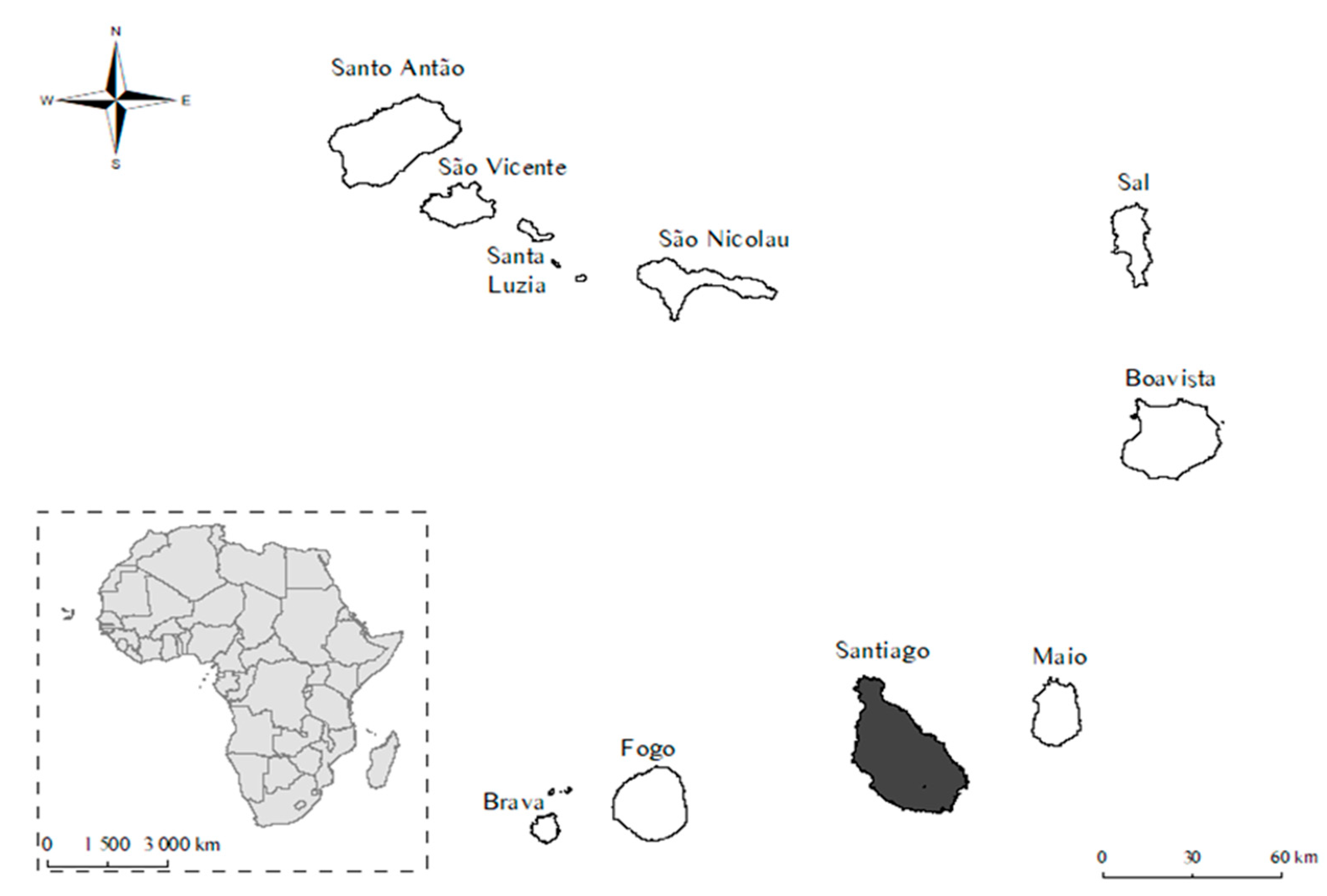
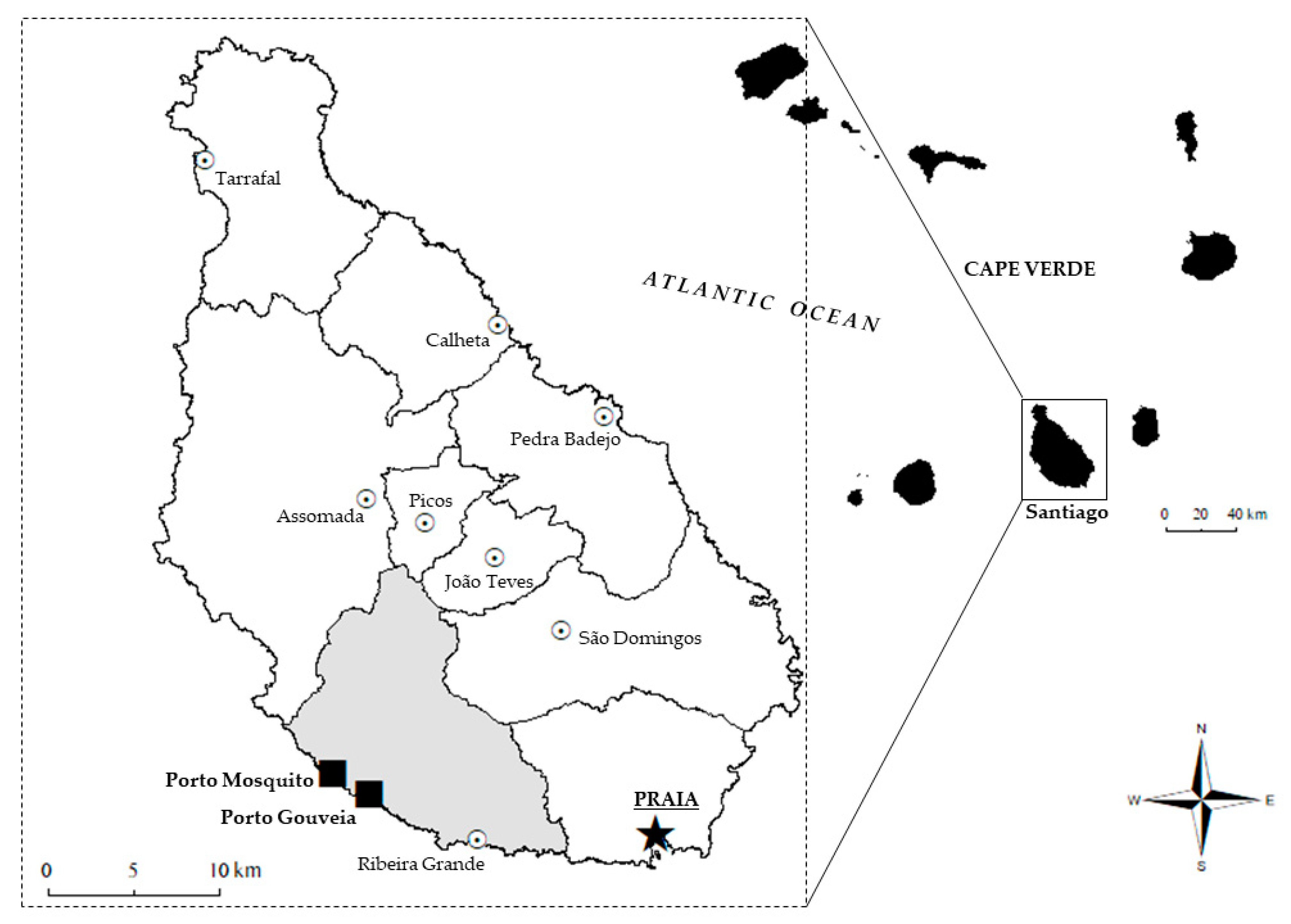

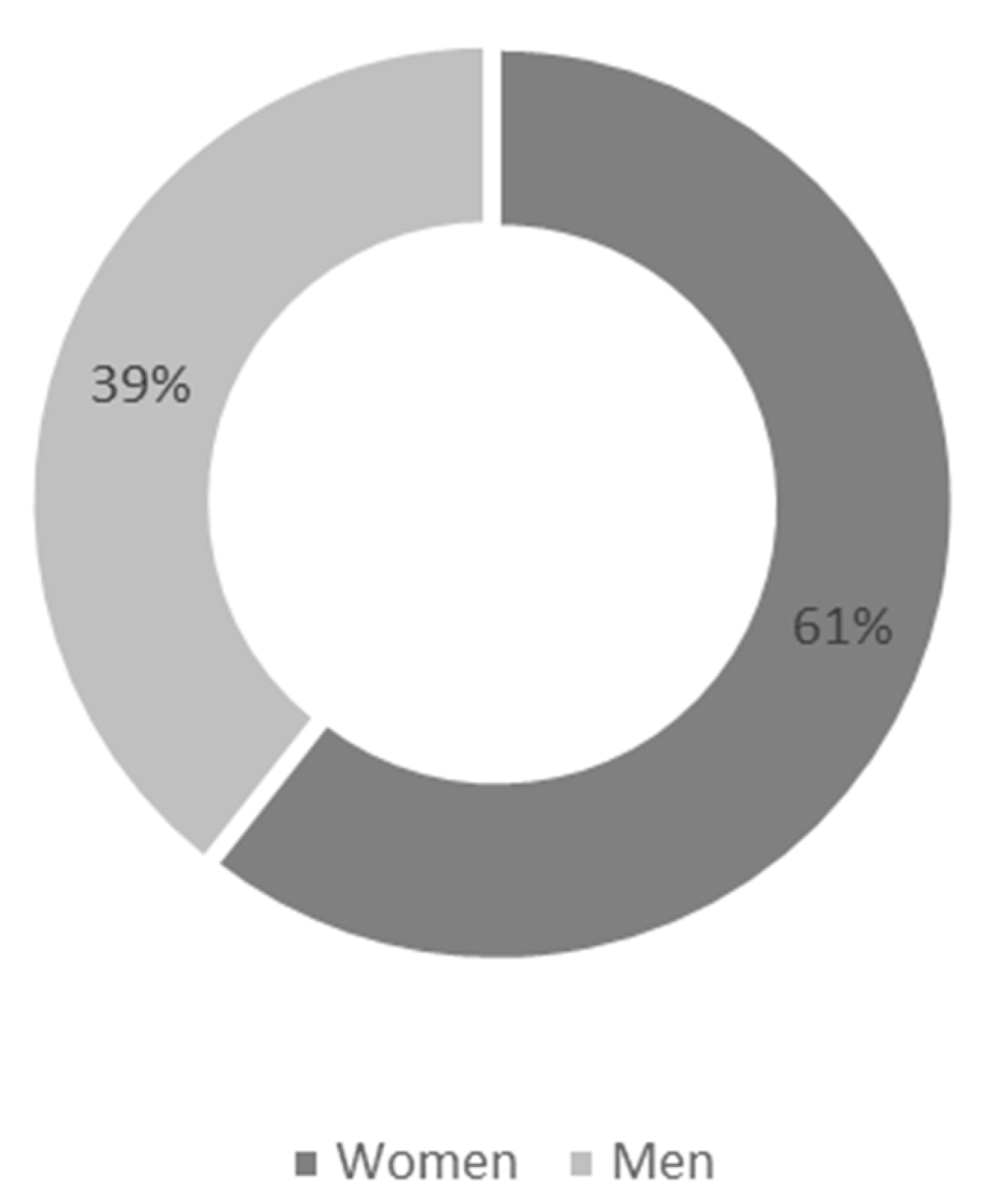


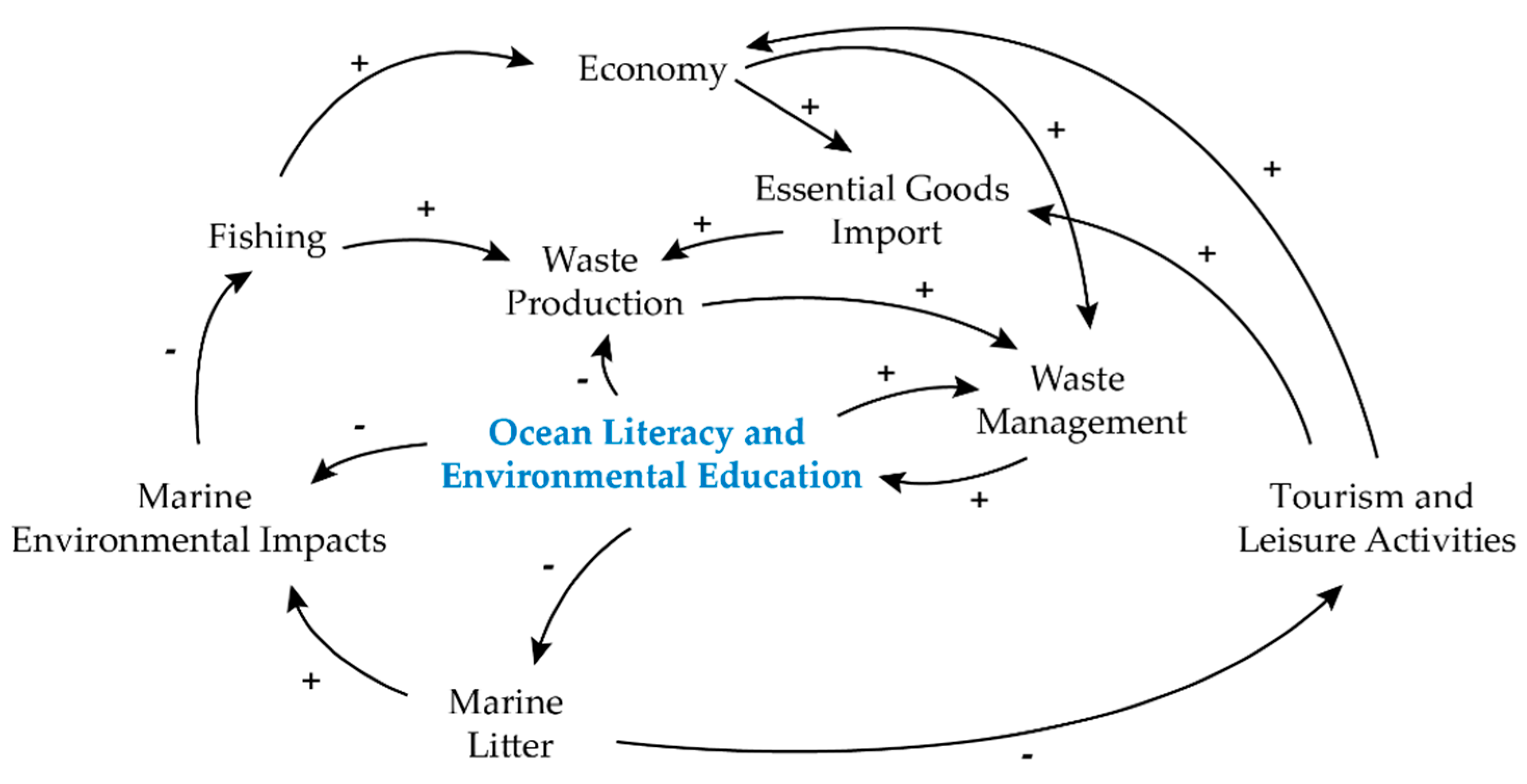
| Topic | Problem | Perceptions |
|---|---|---|
| Causes | Waste Management | The community identified the lack of proper waste management as one of the biggest problems in the island. The lack of trash bins makes people to dispose trash in the hills, which will end up in the sea when it rains |
| Origin of Litter | People were fast to refer that it is now allowed to throw litter to the ocean, so the main part of marine litter comes from land | |
| Population Literacy | The population admitted that there was not enough information regarding this topic, which explains the lack awareness about marine litter. The community also stated that even when there are trash bins in the street, people usually do not put their residues in the correct place and, the majority, end up on the streets | |
| Waste found | Plastic | In both communities, the population could easily identify plastic (water and oil bottles) as the main component of marine debris. Apart from that, some citizens also stated that clothes and shoes were also common to be found in the beaches |
| Impacts | Equipment Damage | Some fishermen stated that, sometimes, the fishnets that are abandoned in the sea, can wrap around the boat propeller, which can damage it, resulting in money losses to repair it. This also makes impossible for fishmen and fish sellers to work, which, for some families, is the main source of income |
| Wildlife at risk | Some participants claimed to have seen some marine species stuck in trash in the ocean and, some of them, even claimed to have found pieces of plastic inside some fish species | |
| Sand Collection | The sand collectors referred that the trash can complicate their job, because some areas are so full of litter, that they must clean it first, so they can collect the sand. This, of course, affects their productivity resulting in losses of income | |
| Solutions | Waste management | The community is aware of the problems regarding waste management and stated that more trash bins in the street and a more efficient trash collection could help prevent the amount of litter that end up in the ocean. Some citizens also pointed out that some materials could be reused as much as possible and recycled to reduce the amount of waste produced |
| Educational Campaigns | The population also stated that some campaigns about this topic should be done with the involvement of the community, in order to bring awareness about marine litter. Some of the activities suggested were beach cleaning campaigns and training sessions to the professors of local schools |
Publisher’s Note: MDPI stays neutral with regard to jurisdictional claims in published maps and institutional affiliations. |
© 2021 by the authors. Licensee MDPI, Basel, Switzerland. This article is an open access article distributed under the terms and conditions of the Creative Commons Attribution (CC BY) license (http://creativecommons.org/licenses/by/4.0/).
Share and Cite
Ferreira, J.C.; Monteiro, R.; Vasconcelos, L.; Duarte, C.M.; Ferreira, F.; Santos, E. Perception of Citizens Regarding Marine Litter Impacts: Collaborative Methodologies in Island Fishing Communities of Cape Verde. J. Mar. Sci. Eng. 2021, 9, 306. https://doi.org/10.3390/jmse9030306
Ferreira JC, Monteiro R, Vasconcelos L, Duarte CM, Ferreira F, Santos E. Perception of Citizens Regarding Marine Litter Impacts: Collaborative Methodologies in Island Fishing Communities of Cape Verde. Journal of Marine Science and Engineering. 2021; 9(3):306. https://doi.org/10.3390/jmse9030306
Chicago/Turabian StyleFerreira, José C., Renato Monteiro, Lia Vasconcelos, Cláudio M. Duarte, Filipa Ferreira, and Euclides Santos. 2021. "Perception of Citizens Regarding Marine Litter Impacts: Collaborative Methodologies in Island Fishing Communities of Cape Verde" Journal of Marine Science and Engineering 9, no. 3: 306. https://doi.org/10.3390/jmse9030306
APA StyleFerreira, J. C., Monteiro, R., Vasconcelos, L., Duarte, C. M., Ferreira, F., & Santos, E. (2021). Perception of Citizens Regarding Marine Litter Impacts: Collaborative Methodologies in Island Fishing Communities of Cape Verde. Journal of Marine Science and Engineering, 9(3), 306. https://doi.org/10.3390/jmse9030306









